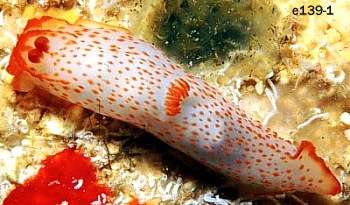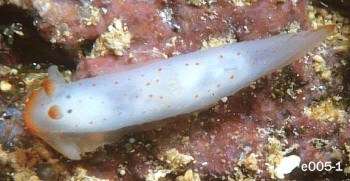

Gymnodoris sp. 3.
Order: NUDIBRANCHIA
Suborder: DORIDINA
Family: Gymnodorididae
PHOTO
UPPER (e139-1): unique specimen, Enewetak Atoll, Marshall Islands at 12 meters, 25mm in length.
LOWER (e005-1): Widespread on Marshall Islands, in 15 -20 meters, 15 - 20mm long. PHOTOS: Scott Johnson.
See message from Scott Johnson below.
Related messages
Gymnodoris with a keeled tail
August 26, 1999
From: Scott Johnson


Hi Bill,
I noticed in one of your forum messages that you're working on the Gymnodorids. Have you ever come across the attached animals? E139-1.jpg is a unique specimen, found at Enewetak Atoll crawling on sand and rubble at night at a depth of about 12 meters. It measured 25mm in length. Its most unusual feature was its tail, which had an upright flattened keel that it used for swimming. It swam by laterally bending the body, and with its tail keel flattened, it could raise itself up off the bottom quickly. I think the only one other species I saw with a similar keel is E005-1.jpg. The latter species is smaller, 15 - 20mm and lives on sand flats in 15 -20 meters of water, where it also is active at night. While I have not seen any for several years now, E005 is more common; I have it recorded from Enewetak, Kwajalein, and Bikini Atolls in the Marshalls.
Scott
johnson@kmr.ll.mit.edu
Dear Scott,
Yes I have found what I think is the same animal in New Caledonia. I suspect yours may be both the same species. The wide foot, tentacular anterior foot corners, backwardly pointing gills and posterior keel are all characteristic. However as I discussed at the Menfi Conference there is nothing to separate it internally from Gymnodoris citrina which doesn't have any of those features. Its all a bit of a puzzle. If you have any, or see any animals, I wouldn't mind some more specimens to try and sort it out.
The posterior keel has an interesting parallel in Plocamopherus imperialis and other species of Plocamopherus which can also swim by lateral flexion of the body when disturbed.
Bill Rudman.
